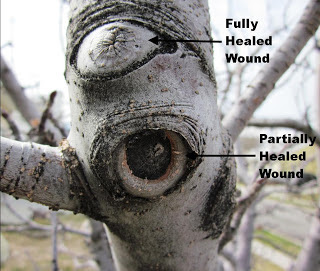How to Prune Large Branches
Two common mistakes that tree pruners make, causing more damage than good are as follows:
- Stripping bark
- Leaving "stubs"
These mistakes are made by amateurs, but so called "professionals" are not immune to this type of work. In addition to causing unnecessary damage, these cuts are unsightly and will attract an array of wood boring and fungal diseases that, once introduced, will cause ongoing problems with your tree.
 |
| Common Fruit Tree Pruning Mistakes |
How to Avoid Stripping Bark
When the above cut was made, the weight of the branch pulled a large strip of wood and bark with it. Luckily the bark broke loose and didn't continue splitting further down the trunk. This kind of damage, on the sever end of the spectrum, could cause the death of your tree. Pruning large, heavy branches high in a tree should be done by a professional with the proper equipment and requires a three cut method. This method may also be used for cutting large branches from a safe height in your own backyard orchard.
 |
| Step One |
Step one: Make a small cut on the bottom of the branch near the trunk. Make the cut just far enough into the branch to stop the bark from splitting down the trunk. Avoid cutting so far into the branch that it begins to pinch and bind your pruning saw.
 |
| Step Two |
Step two: Cut the branch out from your first cut to alleviate the majority of the weight. In this example, the branch fell and was supported by the ground before the stripped bark reached the first cut made in step one. If the branch was higher in the tree, the bark would have continued to pull away until it reached the first cut and then fallen to the ground. If the first cut was not made the bark could have continued stripping off the tree until it reached the base of the trunk. This is the type of damage that has been known to kill trees or cause irreparable damage resulting in ongoing problems and less productive fruit trees.
 |
| Step Three |
The Importance of Not Leaving Stubs
Step Three: Remove the "stub". This is another common pruning mistake. Many gardeners think that leaving part of the branch will allow it to regenerate. Though some tree varieties, like willows, will send new branches, called adventitious branches, from the cambium tissue near a cut, most trees will forever have this "stub". This detail will make your pruning job look unfinished and unprofessional. Also, by pruning branches back to the trunk, your trees will begin to heal, eventually leaving only a scar where the cut was made.
Proper healing of pruning cuts will only occur if the collar and ridge are left intact. Ridges and collars will be discussed in the following posts.
This is where I get lots of comments from professional arborists that say, "Trees don't heal, they seal." Trees don't heal like you and I, they literally have to grow around and seal off pruning cuts and other damage. This is the reason why it is so important to prune your fruit trees often so you don't have to remove large branches. It is not uncommon for large wounds on trees to start rotting before they completely seal off. This is also why topping trees can be so detrimental to their long-term health. So what if you have a neglected fruit tree that has grown too big and you want it to be reduced in size? Well, this link will give you tips on how to do corrective pruning and reduce overgrown trees.
For regular updates regarding the care and pruning of fruit trees please subscribe here:
Thanks for reading! For more information regarding fruit tree care and pruning, please join our Backyard Fruit Growers Facebook Group and subscribe to our Fruit Pruning YouTube Channel. If you are new to pruning, please take this free 9 Lesson Pruning Course.




Comments
Post a Comment